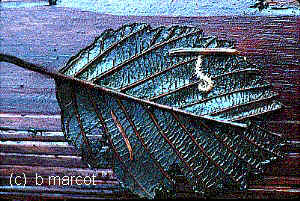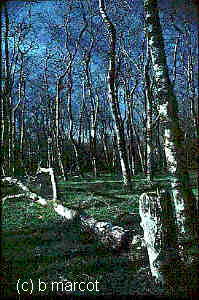
The human mind evolved to dissect the world, to categorize, discriminate, classify, typify. In an evolutionary sense, prejudice -- that is, a slant for viewing things with preconceptions -- is as natural as any phenomenon in nature. Bias of thought, in fact, is probably very economical and essential for avoiding the catatonic bliss of Zen or the "I" state of Martin Buber, which would utterly prevent us from dealing with the world in concrete and utilitarian ways.
In the Zen or "I" states, little in one's immediate surroundings are differentiated, so the task of seeing things as separate entities and events blurs and fades. Zen strives to eliminate distinctions of things in the world, and strives to see the cosmos as one entity. Buber's "I" state is essentially the same, as it is a union of self with deological forces that shape and guide the world.
But the mind is the enemy of Zen and "I"! It forces distinctions,
it categorizes, it sets limits around people and things, all in an attempt
to aid understanding. The mind sees a tree, conjures up the image
of tree-ness, and imparts an entire set of characteristics of what trees
are, the smell of burning autumn leaves, the look of scarlet fall colors,
the feel of the bark and the rustle of the leaves. The eye sees the
tree, and the mind sees the tree as the set of characteristics that define
the general class of tree-ness. 
But how the mind functions to help categorize is not simple; it sees as in different ways. In simple prejudice ("pre-judgment"), we think we know the essential and full nature of a thing or person based on some limited understanding of only few characteristics. This is an adaptive and advantageous economy of energy. If it proves useful only slightly more often than it does not, then it still may tip the cost balance sheet in its favor. Rather than having to explore the feel of the bark and rustle of the leaves of each and every tree we encounter, it is economical to assume that any given tree shares these characteristics.
In this first, simpler version of "seeing as", the mind sees a thing or person as having an entire class of attributes, by simple dint of the thing having at least one or a few of the characteristics of that class. Carried to extreme, however, this births racial stereotypes and bigotry -- utterly unacceptable positions.
In the second, more complex version of seeing as, the mind looks beyond the obvious, the pedestrian, the empirical, and sees a thing or person in metaphor. Or rather, the mind links similar entities, emotions, and relationships into common bond by the mind perceiving that they share some common characteristics. This imbues the thing or person not simply with additional tangible, superficial characteristics, but rather it empowers the thing with more intangible resilience and dimension. The thing seen in metaphor is seen as itself and more than itself, a trans-logical coming out of itself, as if in higher axes of existence.
This is what the purpose of mind is ultimately evolving toward.
Pere Pierre Teilhard de Chardin wrote of the teleological end point, the
goal, of human evolution as the "omega point", at which humanity and material
world and spiritual wholeness of universe revolve in common orbit.
Teilhard's notion is that the human mind is part of the evolving world,
that it is evolving -- "involuting" or developing inwards -- toward what
he termed the "noosphere," where mind becomes more self as it becomes more
involved in the interests and matters of others. The parallels with
Teilhard's philosphy -- developed and written in the 1930's-50's -- with
today's World Wide Web and Internet (how YOU are reading this!) are striking.

Mind in metaphor is the hallmark of great poetry, the genius flashes
of great science, the cerebrations of great literature.
It has birthed and weaned axioms of mathematics, photography
as art, computers that think, and the great liturgies and canons and
poetries that seed churches and nations.
The poet's metaphors in words are not the true metaphors. The poem is not the words. The words are but symbols to guide our understanding to deeper channels. The words of poems are periscopes. As we peer into the world through narrow, roving windows of spoken and written linguistic symbols, all the while the real body is immersed, knowing and feeling and being part of the matrix of the world. To read a poem is not to read the poem, it is to know and feel and to have lived and to relive symbols behind the words.
With metaphor, we carry such incredible potency, such power to know and to love! And the spark that ignites this understanding is sensitivity, compassion, empathy. Metaphor in poem or life is stillborn if it is created or taken without empathy. Only empathy provides the light that unveils symbols behind words. Otherwise, the poem is mere words, sea mere water, mountain mere rock, and metaphor mere prejudice of mind.
Metaphor is more than that. It is the equating of image and sense. Through poetic intuition, through music, through good science ... the burning marrow of metaphor brings new relationship and understanding and hope; we are the keeper of that flame.
Bruce G. Marcot
13 March 1988
Back to the Knowledge Plexus Page
Back to The Plexus Home Page